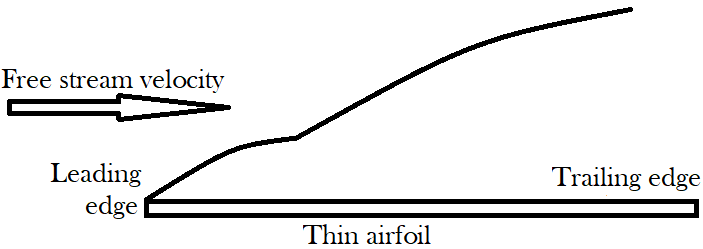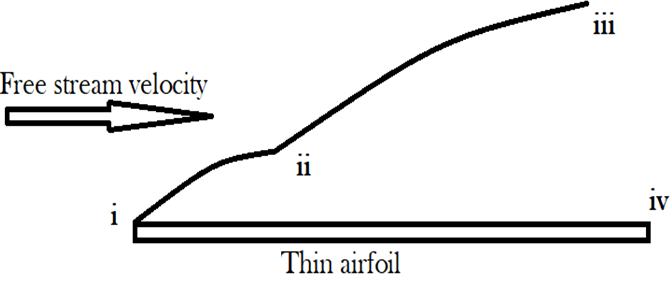This set of Aerodynamics Multiple Choice Questions & Answers (MCQs) focuses on “Turbulent Flow – 2”.
1. For the same angle of attack and chord length, the boundary layer is thicker in_____
a) Turbulent flows
b) Laminar flows
c) Will be equal in both the flows
d) Depends on the velocity of flow
View Answer
Explanation: If we assume the same Reynolds number (which is not true, but only for sake of inference), the boundary layer will be thicker in turbulent flows. This is seen from intuition also and theoretically also. The boundary layer thickness will still be a few centimeters only.
2. An exact analytical solution exists for turbulent flows also like laminar flow over airfoils.
a) False
b) True
View Answer
Explanation: The turbulent flow analysis has no exact analytical solutions. They require empirical data to proceed and all the solutions obtained are approximate.
3. The skin-friction drag coefficient for turbulent flow on the bottom surface of an airfoil, with chord length being 1m is _____ (Reynolds number at the trailing edge Rec=32×105)
a) 0.074
b) 0.0037
c) 0.027
d) 0.0074
View Answer
Explanation: The turbulent skin-friction coefficient, Cf=\(\frac {0.074}{\sqrt[5]{Re_c}}\). Putting the given values, we get the answer as 0.01328. This is the coefficient for any one side of the airfoil and is the same for both top and bottom surfaces.
4. For a Reynolds number Rec=10×105 and chord length 1m, what is the turbulent boundary layer thickness at the trailing edge (in cm)?
a) 0.0216
b) 0.037
c) 2.16
d) 0.37
View Answer
Explanation: The turbulent boundary layer thickness is given by δ=\(\frac {0.37x}{\sqrt[5]{Re_c}}\) where in our question x is the chord length. Solving this we get the thickness to be 2.16 cm or 0.0216m. Note that the answer is not 0.0216 since that is wrong in the required units.
5. The boundary layer thickness for turbulent flow at a distance x with Reynolds number Rex is δ. Which is____
a) Directly proportional to \(\sqrt[5]{x}\)
b) Inversely proportional to \(\sqrt[5]{Re_x}\)
c) Directly proportional to Rex
d) Inversely proportional to x
View Answer
Explanation: The boundary layer thickness for an incompressible, turbulent flow over a flat plate, at a distance x where Reynolds number is Rex is given by δ=\(\frac {0.37x}{\sqrt[5]{Re_c}}\). Thus, the thickness is indirectly proportional to \(\sqrt[5]{Re_x}\).
6. A given flow can be laminar all over an airfoil in a real case. Select the correct statement for the assumption given above.
a) Always true
b) Always false
c) True only for symmetric airfoils
d) Depends on the Reynolds number
View Answer
Explanation: The boundary layer over any body has both laminar and turbulent parts. For an airfoil, the flow encounters laminar skin- friction when it starts near the leading edge and there’s a transition to turbulent skin- friction near the trailing edge in real cases. In ideal cases, we sometimes assume a fully laminar or turbulent flow depending on the Reynolds number.
7. The skin-friction coefficient for turbulent flow Cf is proportional to Rec. The proportionality constant is_____
a) 0.074
b) 0.64
c) 0.33
d) 1.328
View Answer
Explanation: The coefficient of skin-friction drag for turbulent flow is given as Cf=\(\frac {0.074}{\sqrt[5]{Re_c}}\) where Rec is the Reynolds number at the trailing edge. The required constant is 0.074. For laminar flows, the constant of proportionality is different.
8. For a real flow over an airfoil, with Reynolds number in the laminar region as it starts, select the incorrect choice.
a) Flow at trailing edge is laminar
b) Flow is both turbulent and laminar at different places
c) There is a transition region between leading and trailing edge
d) Flow at trailing edge is turbulent
View Answer
Explanation: In actual cases, where we don’t have an ideal flow, no flow is fully laminar or turbulent. It is laminar as it starts and becomes turbulent near the trailing edge. It has a transition region where the transition from laminar to turbulent flow takes place.
9. The transition point for a flow can be found using____
a) Average of Reynolds numbers at leading and trailing edges
b) It is always the mid-chord
c) Hit and trial methods
d) Critical Reynolds number
View Answer
Explanation: The critical Reynolds number is usually found from experiments and then using the free-stream flow parameters we can calculate the critical point, which is where the transition from laminar to turbulent flow takes place. All the other options are not the right ways to find the transition point.
10. When the free-stream velocity is made one-third, the transition point moves downstream.
The given statement is true or false?
a) True
b) False
View Answer
Explanation: The transition point is given as xcr=\(\frac {Re_{x_{cr}} μ_∞}{\rho_∞V_∞ }\). Thus, from the formula, we can see that as the velocity is decreased xcr increases i.e. the transition point moves away from the leading edge (or moves downstream).
11. The phenomena best represented by the profile given in the following figure is_____

a) Shock waves
b) Boundary layer
c) Pressure distribution
d) Variation of velocity
View Answer
Explanation: For a flat plate airfoil, the boundary layer profile is as given above in the figure always. The other options are incorrect for this case since they don’t resemble the profile given in general.
12. For the boundary layer profile given below, select the regions which best represents where the transition in flow is taking place and mark the leading edge (respectively).

a) i, ii
b) ii, i
c) iii, ii
d) iv, ii
View Answer
Explanation: The boundary layer thickness increases with the distance measured from the leading edge for both laminar and turbulent flows. It is smallest at the leading edge. The region of transition is marked by a change in the pattern of the boundary layer, depicted by ii. The region iv is the trailing edge and iii is the thickness of the boundary layer at the trailing edge.
13. Which of the following gives a better approximate distribution of drag over thin airfoils?
The given percentages are for skin- friction drag and pressure drag respectively.
a) 85, 15
b) 50, 50
c) 64, 35
d) Inadequate data
View Answer
Explanation: The thin airfoils can be considered as 2-D streamlined bodies. For such cases, the drag distribution is 85% for skin-friction drag and 15% for pressure drag. This assumption is valid for thin airfoils, not always.
14. All bodies have skin-friction contribution more than that from the pressure drag.
a) False
b) True
View Answer
Explanation: The given statement is incorrect. For streamlined bodies, the drag distribution is 85% and 15% for skin-friction and pressure drag respectively. But as the body becomes less streamlined, the case gets reversed. i.e for blunt bodies pressure drag is more important.
Sanfoundry Global Education & Learning Series – Aerodynamics.
To practice all areas of Aerodynamics, here is complete set of 1000+ Multiple Choice Questions and Answers.
If you find a mistake in question / option / answer, kindly take a screenshot and email to [email protected]
- Check Aerospace Engineering Books
- Practice Aerospace Engineering MCQs
- Check Aerodynamics Books
- Check Aeronautical Engineering Books
- Practice Aeronautical Engineering MCQs
